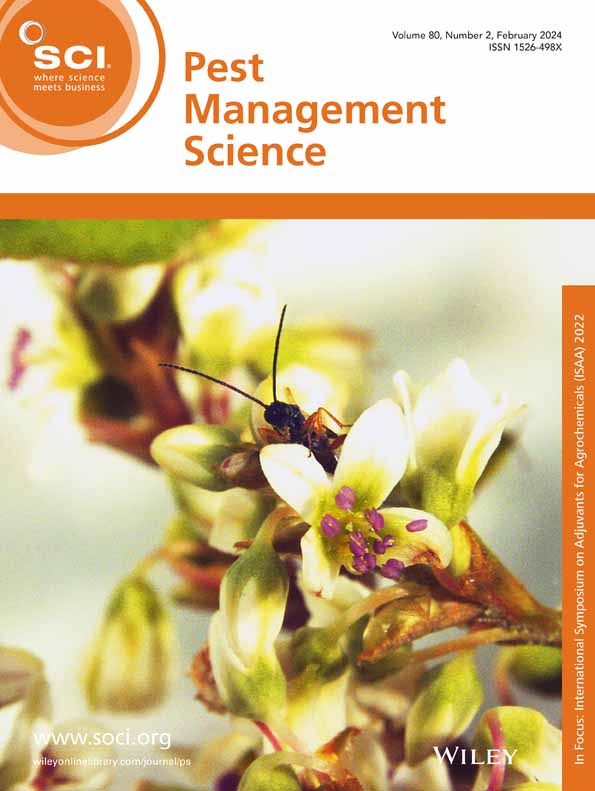通过RNA干扰靶向V - atp酶亚基破坏木松的超微结构和正常生命活动:一种可持续管理松材枯萎病的新策略
IF 3.8
1区 农林科学
Q1 AGRONOMY
引用次数: 0
摘要
背景松材线虫(Bursaphelenchus xylophilus, PWN)是一种具有破坏性的松树寄生虫,可在寄主树木中引起广泛的死亡。化学农药通常用于防治PWN;然而,它们的长期使用推动了PWN中农药抗性的演变,并构成了环境风险。基于RNA干扰(RNAi)的生物农药是一种很有前途的替代方法,具有物种特异性靶向、高效和减少生态足迹的特点。为了设计针对PWN的RNAi生物农药,我们系统地研究了V型质子atp酶(V - atp酶)家族的8个V1结构域亚基(A-H),使用了整合转录组学分析和生物信息学分析。设计、合成了8种相应的双链rna,并对其进行了功能评价。靶向这些亚基的RNAi显著损害了PWN的生存能力、运动能力、摄食效率和繁殖力。值得注意的是,dsV‐ATPase‐H表现出最明显的干扰效果:暴露于700 ng μL−1 dsRNA 72小时可诱导J4期线虫80.12%的校正死亡率。该处理使每条线虫的产卵量从7个减少到1个,种群密度从8136只减少到705只。透射电镜进一步显示,RNAi破坏了线虫的超微结构,表现为表皮厚度改变和肠道微绒毛密度降低,从而破坏了结构和功能的完整性。结论我们的研究表明,V - atp酶亚基(A-H)可能作为基于RNAi的PWN控制的分子靶点。这项研究首次在超微结构水平上揭示了RNAi靶向PWN中V - atp酶(A-H)亚基对其关键生命活动的调节作用。提出了一种可持续的基于RNAi的松材枯萎病防治策略。©2025化学工业协会。本文章由计算机程序翻译,如有差异,请以英文原文为准。
Targeting V‐ATPase subunits via RNA interference disrupts ultrastructural and normal life activities in Bursaphelenchus xylophilus: a novel strategy for sustainable pine wilt disease management
BACKGROUNDPine wood nematode (Bursaphelenchus xylophilus , PWN), a devastating pine parasite, induces widespread mortality in host trees. Chemical pesticides have been conventionally used for PWN control; however, their prolonged use drives the evolution of pesticide resistance in PWN and poses environmental risks. RNA interference (RNAi)‐based biopesticides represent a promising alternative, offering species‐specific targeting, high efficacy and a reduced ecological footprint.RESULTSTo engineer RNAi biopesticides against PWN, we systematically investigated eight V1‐domain subunits (A–H) of the V‐type proton ATPase (V‐ATPase ) family using integrated transcriptomic profiling and bioinformatic analyses. Eight corresponding double stranded (ds) RNAs were designed, synthesized, and functionally evaluated. RNAi targeting these subunits significantly impaired PWN viability, motility, feeding efficiency, and fecundity. Notably, dsV‐ATPase‐H exhibited the most pronounced interference efficacy: 72 h exposure to 700 ng μL−1 dsRNA induced 80.12% corrected mortality in J4‐stage nematodes. This treatment reduced egg production from 7 to 1 egg per nematode and population density from 8136 to 705 individuals. Transmission electron microscopy further revealed that RNAi disrupted nematode ultrastructure, manifesting as altered cuticle thickness and reduced intestinal microvilli density, thereby compromising structural and functional integrity.CONCLUSIONSOur study demonstrates the potential use of V‐ATPase subunits (A–H) as molecular targets for RNAi‐based PWN control. This study is the first to reveal, at the ultrastructural level, the regulatory effects of RNAi targeting V‐ATPase (A–H) subunits in PWN on their critical life activities. It proposes a sustainable RNAi‐based strategy for controlling pine wilt disease. © 2025 Society of Chemical Industry.
求助全文
通过发布文献求助,成功后即可免费获取论文全文。
去求助
来源期刊

Pest Management Science
农林科学-昆虫学
CiteScore
7.90
自引率
9.80%
发文量
553
审稿时长
4.8 months
期刊介绍:
Pest Management Science is the international journal of research and development in crop protection and pest control. Since its launch in 1970, the journal has become the premier forum for papers on the discovery, application, and impact on the environment of products and strategies designed for pest management.
Published for SCI by John Wiley & Sons Ltd.
 求助内容:
求助内容: 应助结果提醒方式:
应助结果提醒方式:


